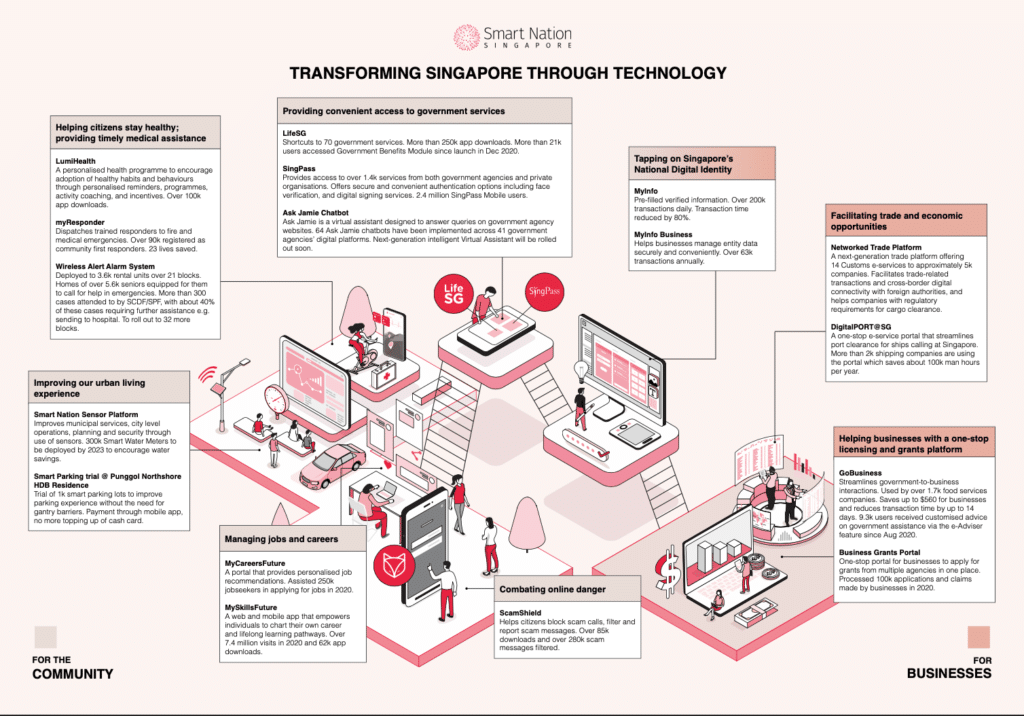Cities and metropolitan areas have a huge impact on worldwide greenhouse emissions. There has been much discussion on how we could reduce this dangerous trend by making cities greener. In discussing different strategies and policies that can be implemented, Melbourne stood out as the world’s leader in the “15-Minute City” strategy. Cities such as Berlin and Athens were praised for their improvement of the public transportation system over the last months, while Bangkok received a lot of attention for its efforts to create more green areas in the city. The Asian city-state of Singapore is considered a leader in green urban development. We take a look at why it’s one of the world’s most sustainable cities and what other cities can learn from it.
—
Over the last few years, come summer season, the stories that dominate the news are the same again and again: record-breaking temperatures and extreme heat waves, heavy rainfall and deadly floods. And every time, thousands of people die as a result of these severe and anomalous events. These are clearly all signs of climate change, but the reality is that we are just at the beginning: even though headlines seem to repeat something that we have already read, these events get worse every year and we can no longer afford to ignore them.
It is no secret that climate change triggers migration. What is concerning is that experts now predict that in the next thirty years, we will have an estimate of 200 million climate migrants, meaning that one in every 45 people in the world will be displaced by climate change. While it is undeniable that marginalised groups and economically poor countries are disproportionately affected by climate change, areas in high-income nations are certainly not spared by extreme weather events. The deadly floods that recently surprised Western Europe and the Chinese province of Henan, the massive wildfires in North America and the catastrophic water crisis that Iran is experiencing are just the latest examples of a crisis that is getting worse by the day. There is something that these events have in common: they are all exposing the climate vulnerability of areas that no one thought would be at risk and most of which never had to deal with disastrous events before.
Even though more and more nations seem to have finally started taking the climate issue seriously, with China aiming for carbon neutrality by 2060 and the European Union and the United States by 2050, these nations still need to figure out how to transition to clean energy. However, even once they start implementing new policies, it will still take time to see real effects. This means that an overturn of the climate crisis is unlikely to happen any time soon. Instead, in the coming years the world will likely keep experiencing extreme weather events that will consequently force millions of people to migrate.
Even though there is no single culprit that can be held responsible for the climate crisis, there is no doubt that cities are huge greenhouse gases emitters. It is therefore crucial that, when planning new sustainable policies to reach carbon neutrality, governments must figure out a way to make their cities more sustainable. Some have already started implementing strategies and building infrastructures aimed at reducing the urban greenhouse emissions. But which city can be considered the world’s most sustainable, and what can other cities learn from it?
One that tops most indexes ranking the world’s most sustainable cities is, unsurprisingly, Singapore. With just over 5.6 million inhabitants, the Asian city-state has the second greatest population density in the world. Every aspect of life there from the education and healthcare system to the quality of life and housing, is ranked at the top of key social indicators. Singaporeans enjoy the fastest internet connection speed and one of the lowest infant mortality rates worldwide. It is no wonder then that in the Smart City Index published annually by the Institute for Management Development in collaboration with Singapore University for Technology and Design (SUTD), Singapore ranked first out of 109 cities for two consecutive years.
You might also like: 5 Innovative Urban Solutions to Tackle Climate Change in Cities
3 Ways in Which Singapore Succeeds in Green Urban Development
1. Public Transports and Traffic Regulations
When talking about the sustainability of urban areas, an efficient, affordable, and modern public transport system is of the utmost importance. Even though Singapore’s network has a margin for improvement, the city has been praised for its efforts to push for electric vehicles and the use of data in transportation planning, all strategies that have contributed to an overall very sustainable urban transportation system – from the customer satisfaction and the innovation to the financial and internal management – as a 2011 study by Rahman and Chin has shown (see Figure 1). Despite its high population density and the significant land constraints, in the last few years the government has focused on implementing policies that were successful in reducing private vehicles’ dependency, ensuring a smooth traffic flow, and maintaining an overall affordable transport network. For these reasons, Singapore’s urban transport is considered a ‘global landmark’. Its ability to constantly adapt to the growing population has been leading the way for other rapidly developing Asian cities to develop their own sustainable transport system.
| Perspective Themes | Themes | Overall score |
| Customer | User satisfaction and social coherence | 4.1 |
| Environmental protection | 3.5 | |
| Financial | Revenue and economic enhancement | 4.5 |
| Effective cost management | 4.0 | |
| Internal process | Institutional efficiency | 4.8 |
| Built environment and land-use | 4.5 | |
| Management of transport modes | 4.1 | |
| Deployment of smart technologies | 4.7 | |
| Learning and Growth | User behaviour, feedback and adaptation | 4.3 |
| Research and innovation | 4.5 |
Scores of sustainability indicators regarding Singapore’s public transport system, adapted from Rahman & Chin (2011)
You might also like: Top 7 Smart Cities in the World
2. Green Areas
In early 2021, the Government of Singapore announced the audacious plan of building the avant-garde eco-smart city of Tengah, the western region of the island, which will be home to five residential districts and a total of 42,000 houses spread out over 700 hectares of land. The city will have several sustainable features such as an automated trash collection system ensuring a cleaner environment as well as pedestrian-friendly zones and underground roads. This ambitious project will resemble a proper ‘forest town’ characterised by huge green areas such as public gardens and a nature reserve.
Despite the relatively small population, per-capita emissions in Singapore are relatively high, with greenhouse gases coming mainly from the elevated use of air conditioning, one of the main sources of energy consumption given the tropical temperatures affecting the city all year round. To tackle this issue, urban planners are implementing a centralised cooling system to regulate the temperature in households, which they see as a more energy-efficient alternative to individual air-conditioning units. This ‘forest town’ plans to add nature to an urban area that already features several parks, vegetation, vertical gardens, and green spaces in both indoor and outdoor spaces. Indeed, according to the Centre for Liveable Cities (CLC), in 2020 nearly 47% of Singapore’s land was covered in green space, making it a true ‘garden city’.
3. Technology and Digitalisation
With the introduction of the Smart Nation program in late 2014, Singapore started a nationwide digital revolution and quickly became the leader of the digitalisation wave taking place across Southeast Asia (see Figure 2). The programme introduced a series of innovations across different sectors such as Strategic National Projects, Urban Living, Transport, Health, Government Services, and Businesses. Some concrete examples of how the program was implemented are the introduction of a National Digital Identity and of services to facilitate contactless and e-payments, the completion of smart homes relying on environmental-friendly energy sources, as well as green interventions in urban mobility, such as the launch of trials of autonomous buses and shuttles.

Transforming Singapore through technology, Smart Nation Singapore (2014)
Contactless payments have been widely used in the last years but have gained even more popularity among Singaporeans during the COVID-19 pandemic as a safer way to pay. During the last months, Singapore turned into a global market leader in cashless payments, which saw an increase of 12% between 2019 and 2020, as well as an overwhelming number of people – 84% of the city’s residents and 92% among Generation Y – responding positively to this mode of payment. These data are proof that Singapore could turn into one of the first totally cashless societies sooner than expected.
You might also like: 4 Commonly-Used Smart City Technologies
Another sector that has seen a surge in digital services is the healthcare industry. While Western countries are far from it, nowadays digital health is considered the norm in China and the trend is spreading rapidly across other Asian countries. Thanks in part to the pandemic, offers for on-demand medical consultations have increased sharply in Singapore over the last months. Digitising healthcare has several benefits, such as improving the operational efficiency of healthcare providers, reducing administrative costs and waiting times, and, as more and more studies are finding, even allowing better and ongoing monitoring of patients through, for example, the use of wearable Internet of Things (IOT) devices.
Even though the digitalisation and technological advancement of some of the sectors mentioned above may not seem strongly related to sustainability as, for example, interventions in the transportation industry, decreasing the circulation of physical money through cashless payment systems, or of people through digital healthcare, can have a significant impact on CO2 emissions and waste production. According to data by US healthcare provider Kaiser Permanente, replacing the average outpatient paper-based record with a digital version or physical visits by video consultations would drastically reduce the generation of greenhouse gases, saving approximately 1.7 million tons of carbon emissions.
Final Thoughts
In the last decade, Singapore has proven to have the potential to be a worldwide leader in sustainability. With technological advancements, green interventions, and smart strategies applied across all main sectors, it has repeatedly earned its reputation as one of the world’s greenest, smartest and most sustainable cities. The stability of Singapore’s economy allows it to divert attention to pressing environmental issues and increase investments and deployment of resources to tackle them. Even though much more can be done, Singapore’s story is a successful one and other big cities can only learn from it.
Especially in densely populated urban areas, having green spaces and an efficient and cleaner public transport network, a solid waste management system, and a smart deployment of the resources available can have a massively beneficial impact on the environment. And despite there not being a universal solution because of the uniqueness of every city on earth, Singapore’s interventions and its approach to a more sustainable future can certainly serve as an example and paves the way for more sustainable cities across the rest of the world.
You might also like: Top 5 Most Sustainable Cities in the World in 2022


















